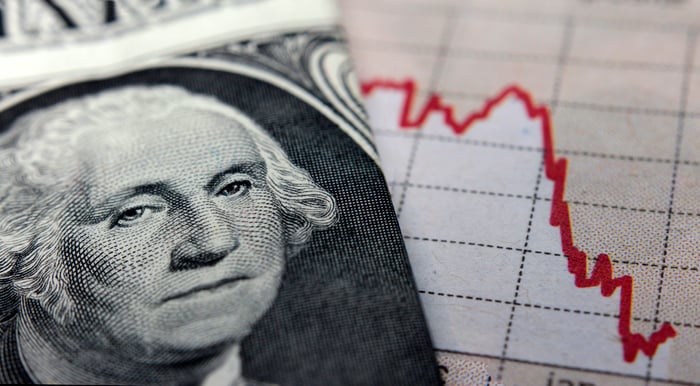Over lengthy periods, Wall Street is an undeniable moneymaker. But over shorter time frames, directional movements in the ageless Dow Jones Industrial Average (^DJI 0.40%), broad-based S&P 500 (^GSPC 1.02%), and growth-focused Nasdaq Composite (^IXIC 2.02%) are unpredictable and impossible to forecast with any true accuracy.
Nevertheless, this doesn't stop investors from using various economic datapoints and predictive tools to forecast what's to come for the Dow Jones, S&P 500, and Nasdaq Composite. The thing is, these forecasts don't always offer the rosiest of outlooks for Wall Street.

Image source: Getty Images.
A yield-curve inversion is often bad news for the U.S. economy and stock market
One of the most popular datapoints used by investors to gauge the health of the U.S. economy and predict where the stock market may head next is the Treasury yield curve.
The yield curve is a chart that depicts the yield an investor would receive relative to when a specific Treasury bond will mature.
In a healthy economy, the yield curve would be expected to slope up and to the right. This is to say that Treasury bonds maturing 10, 20, or 30 years from now will sport higher yields than Treasury bills set to mature in three or six months. The longer an investor's money is tied up (i.e., the greater the opportunity cost), the higher the yield should be.
However, when investors are worried about the outlook for the U.S. economy, it's not uncommon to see the Treasury yield curve invert. Just as the name suggests, an inverted yield curve is where short-term Treasury bills sport higher yields than bonds set to mature years or decades from now.
The interesting thing about yield-curve inversions is they're usually a precursor to U.S. recessions. While not every yield-curve inversion is followed by a recession, every recession following World War II has been preceded by a yield-curve inversion of the 10-year Treasury bond and three-month T-Bill.
Yield-curve inversion shows recession to land soon-
-- Puru Saxena (@saxena_puru) October 14, 2023
- Shortest lag was 1973 recession --> 3.7 months
- Longest lag was 2007 recession --> 15.3 months
Based on history, recession to start latest by Q1-end pic.twitter.com/p4YBRS4MyL
According to a recently published analysis by Barry Bannister, the managing director and market strategist at Stifel, 10-year/three-month Treasury yield-curve inversions over the past 55 years paint a crystal-clear picture of what's next for the U.S. economy and Wall Street.
As the chart provided by Stifel demonstrates, an inversion of the 10-year/three-month yield curve (based on 50-day moving averages) hasn't provided a false recession signal since 1968. A yield-curve inversion has front-run a U.S. recession by 3.7 months on the short end and 15.3 months on the long end over the past 55 years. With the current inversion (based on the 50-day moving average) at close to 10 months, it would suggest the U.S. economy is mere months away from dipping into a recession.
Although the U.S. economy and stock market aren't tied at the hip, recessions have, historically, not been good news for equities. A downturn in the U.S. economy usually leads to higher unemployment, weaker consumer spending, and at least a temporary decline in corporate earnings.
Since 1929, approximately two-thirds of the S&P 500's peak-to-trough declines have occurred after, not prior to, an official recession being declared. In other words, the existing yield-curve inversion appears to signal that "down" is the likeliest direction stocks will head in the coming months.

Image source: Getty Images.
More than a century of available data incents patience and optimism
While the ongoing yield-curve inversion represents a potential black eye for Wall Street, taking a step back and looking at more than a century of total-returns data for the broader market demonstrates why patience is so valuable.
As much as we may dislike downturns in the U.S. economy, they're both normal and inevitable. Something else that's perfectly normal is periods of economic expansion lasting disproportionately longer than recessions. Whereas all 12 recessions following World War II have lasted just two to 18 months, most economic expansions have continued for multiple years.
This disproportionate optimism is also seen on Wall Street. In June, wealth management company Bespoke Investment Group calculated the average length of the 27 bull markets and 27 bear markets that have occurred in the benchmark S&P 500 since September 1929. Over the past 94 years, the typical bear market has lasted 286 calendar days, or the equivalent of roughly 9.5 months. Meanwhile, the average bull market has lasted more than 3.5 times as long -- 1,011 calendar days.
But there's another even more convincing dataset for optimists that extends well beyond a century.
Every year, the analysts at market insights company Crestmont Research update their comprehensive dataset that examines the rolling 20-year total returns, including dividends paid, of the S&P 500. Even though the S&P 500 didn't expand to 500 companies until 1957, and the index didn't come into existence until 1923, many of its components could be found in other major indexes prior to 1923. This allowed Crestmont to back-test its rolling 20-year data all the way to 1900, which provided 104 rolling 20-year periods (1919 to 2022) of total-returns data.
Crestmont Research's more than 100 years of back-testing shows that every rolling 20-year period since the beginning of the 20th century -- 104 out of 104 -- resulted in a positive total return. Whereas you can count on one hand how many of these rolling 20-year periods produced annualized total returns of less than 5%, more than 50 of these 104 periods generated annualized total returns of between 9% and 17.1%.
These are return levels that, in all likelihood, would have crushed the prevailing inflation rate and led to serious wealth creation for patient investors.
Despite historic yield-curve data providing Wall Street with an ominous warning for the coming quarters, long-term investors have more than a century of data to suggest they're well positioned for future gains regardless of what's thrown their way.





